How to fight hunger: A look inside your local food bank
What is the Community Food Sharing Association?
It's a network. A registered charity. A provincial organization with dedicated staff, supported by dedicated volunteers. But more than that, it's a machine built to combat hunger in Newfoundland and Labrador. It's hundreds of unseen hands, passing food from those who give it, to those who need it.
The tiny parts of that machine are all around you. There's one nearby, even if you're lucky enough to have never been there.
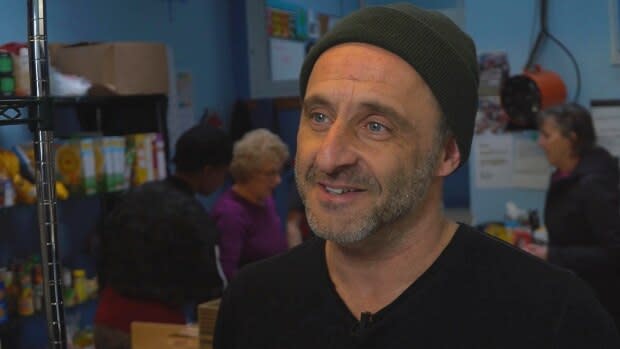
"There is a church basement somewhere, or a hall that's being used one night a week or one night a month to do the good that's needed in their communities," said Wanda Hillier, the association's chairperson. "Most of these organizations are being run by volunteers. So you don't find them in big buildings with signage and billboards."
In Newfoundland and Labrador, there are 56 groups that operate local food banks. They all collect their own supplies, keeping locally donated food in the local community. But when the shelves run low, they all rely on the Community Food Sharing Association.
Think of it as a food bank for food banks.
This December, CBC's Warm Hearts campaign is raising funds for food banks in your community. You can learn more about our campaign here, and keep reading to learn how your donations reach people in need.

The hungriest time of year
Tuesday is always a busy day at the association's warehouse in St. John's (the association got a new warehouse after the old one burned down in early 2019. Read that story here). Step inside, and you find a small army of volunteers, getting food packed up and ready for the road on pickup day.
"Any food banks that are located in the metro area and are running low and need to supplement their own supplies can visit our warehouse on Tuesdays and Thursdays," said Hillier.
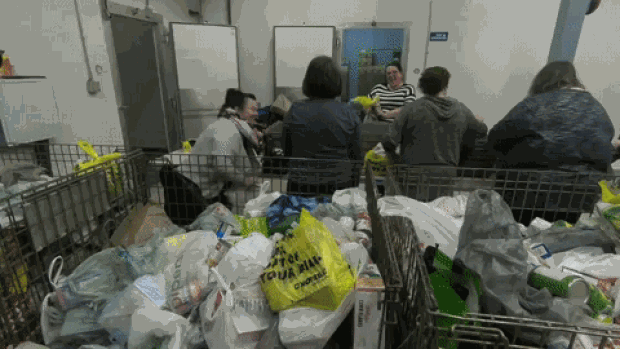
On this Tuesday, a dozen or so women are donating their time to pack shipping crates. Nearby are bins overflowing with grocery bags, collected at the recent St. John's Santa Claus Parade.
The holiday season is the busiest time of year for most food banks. For example, the Bridges to Hope food bank takes in nearly half its annual donations in the month of December. But Hillier says the season of giving, for many people, is also a season of need.
"This is the time of year where we see the biggest demand, mostly because we've got a lot of people at home," Hillier explains. "Kids aren't in school, they're not availing of back-to-school lunch programs, breakfast programs. You've got more company coming and going, you've got more children hanging around the house than you normally do. It puts more pressure on houses that are food-insecure all year."
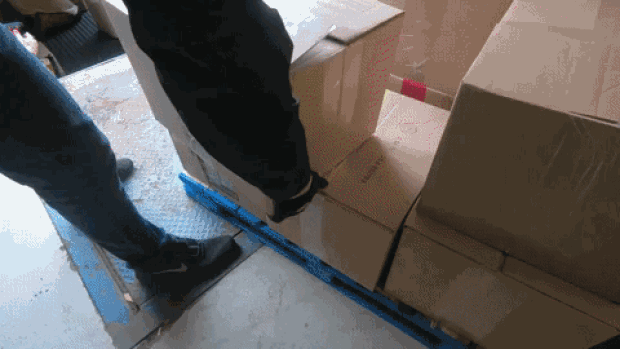
The volunteers work furiously, their hands darting from the grocery bags to the packing crates, meticulously divvying up the donations. No sooner are the crate lids sealed than they're loaded onto dollies and wheeled away. Outside, vans are already waiting.
Jody Williams is the manager of the Bridges to Hope, which operates one of the largest food banks in St. John's. Every Tuesday morning, he rents a U-Haul van on Kenmount Road, then drives it across the street to Pippy Park, where the warehouse is located. When warehouse doors roll up, Williams is waiting outside with the engine running.
The packing crates that were assembled just moments ago by the volunteers are handed out the doors to Williams and another Bridges to Hope team member, who pile them into the back of the U-Haul. When the van fills up, they're gone in a flash, making their short drive to the Bridges to Hope food bank in central St. John's.
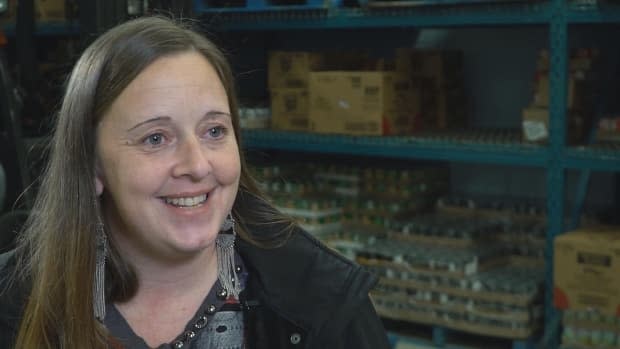
When the van pulls into the driveway, the entire packing and sorting process plays out in reverse. The crates are hustled through the door, where yet more volunteers are waiting. The boxes are ripped open and their contents repacked into smaller takeaway bags for individual food bank users. There's not much chit-chat. No time for it.
"Today we have 30 people outside waiting to get in, because we're closed on Monday," said Williams. "This time of year demand, obviously, is going up. People are trying to save money to spend on gifts."
By noon, food that had been stacked in the association warehouse will be in the cupboard, on the table, even in the belly of a person in need. The whole process is also a tidy example of how the food bank network functions.

Food Banks Canada sends food (and money) to Newfoundland and Labrador through the Community Food Sharing Association. It, in turn, sends food to the partner food banks throughout the province. There, it's combined with locally donated food, and finally turned over to people in the community.
But who are those people? Who's out there going hungry?
Data bites
Food Banks Canada releases an annual "Hunger Report," with detailed information on each province. In Newfoundland & Labrador, 53 per cent of food bank users are single person households. Picture an adult, living alone, with no one to share the monthly bills. Shockingly, more than 30 per cent of food bank users are children under 18.
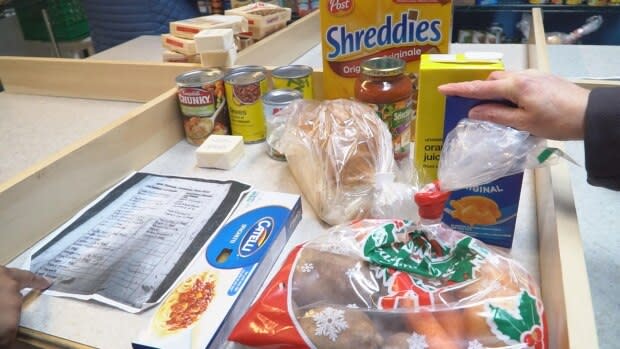
The vast majority, nearly 72 per cent, of food bank users rely on social assistance for their main source of income. But there are those — 7.4 per cent — whose main income is from their job. For Hillier, it's a sad statistic.
"If you're a single person living on your own, even on a decent wage, with cost of living right now, and that's not just in Newfoundland, that's across Canada, it's not enough. It's just not enough," she said.
In 2019, there were more than 10,000 visits to food banks across the province, a five per cent increase from the year before.
Where does all that food come from? You name it.

It comes from corporate donations, from community food drives, from local grocery stores and from Mom and Pop down the street, saving up a few cans to drop in the donation bin. But one of the most important kinds of food is off-limits to all but the luckiest food banks.
The fridge factor
At the Bridges to Hope food bank, Jody Williams stands next to the organization's prized possession. It's tall, glowing, and hums faintly through the din of food being sorted. This single object has increased the food bank's nutritional output by orders of magnitude. And all it cost was a couple thousand bucks.
"I applied for a grant and I got this cooler," he said. "So I know it sounds simple, a walk-in cooler, a standup cooler. But most food banks don't have access. But because I have this cooler we can offer eggs, usually we have yogurts, cheese strings for kids."

In this province, three out of four food banks don't have a refrigerator. They can't take milk or eggs. They can't give out fresh fruit or vegetables. For want of a basic appliance, local food banks users are shut off from all that nutrition.
"I wish I had more success stories to tell you of local food banks that have refrigeration. There just aren't that many yet," said Hillier. "We all want to do it. We just don't have the manpower, or the logistics, or the network is not strong enough to do that right now."
How to lend a hand
So how do you solve a problem like hunger?
Hillier says that with our current approach, solving isn't on the menu. At best, we're maintaining, holding the line. Without food banks, and the volunteers that keep them running, hunger in this country would be far, far worse. But while food banks can feed a hungry person, they can't change the circumstances that left them hungry in the first place.
"Usage is not growing significantly, but the demand is remaining steady," said Hillier. "We haven't figured out a way to decrease the demand, unfortunately. In Newfoundland or in Canada."
A simpler question may be, how can you help? Jody Williams says the answer to that question is simple indeed.
"The best way to help a food bank is to donate money. That's the truth," Williams said. "Say you went out to shop for me and you spent $20. One thing you bought was pasta sauce and you paid a $1.89. With my connections, that's three pasta sauces I can get. Plus you're spending your gas money; you have to drop it off to me now, then I have to have volunteers take it out of bags and put it into something."

Through a combination of wholesale pricing, charity discounts, tax breaks and the deferred cost of volunteer time, Williams says a food bank can vastly increase the purchasing power of your dollar.
"Of course, we always appreciate food, because food is money," Williams added. "But I do want people to know that like, as far as bang for your buck goes, one dollar is three to five dollars. So look at it that way."
Back at the Community Food Sharing Association warehouse, Hillier is watching the last of the day's food pickups. The pile of plastic crates that were packed just hours ago is long gone. And in a couple of days, they'll do it all over again.
All over the province, there are scenes like this playing out every week, every day. Somewhere close by, there are shelves being stocked, hampers being sorted, food drives and fundraisers being organized. There are people giving money. There are people giving time.
It takes all those hands, pulling together, to make sure food banks are there for those that need them. But Hillier says what every food bank needs is another pair of hands.
"If people could just appreciate that and look around their own communities, and their own networks for those who may need a little bit of help or assistance, I think it would go a long way."
Read more from CBC Newfoundland and Labrador


